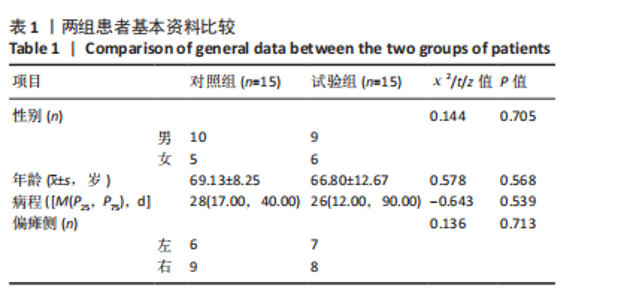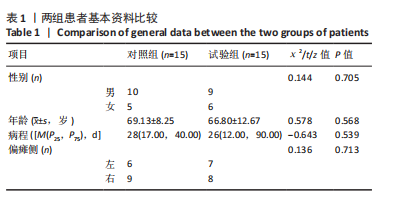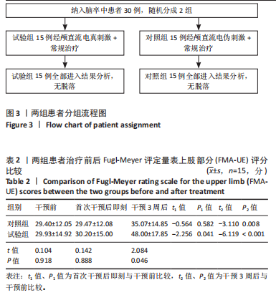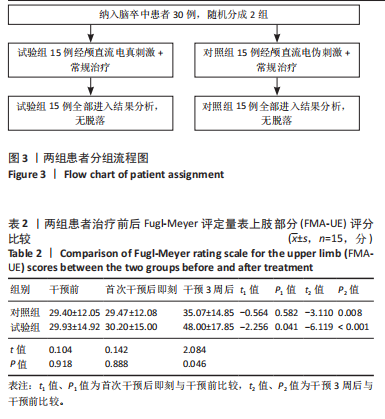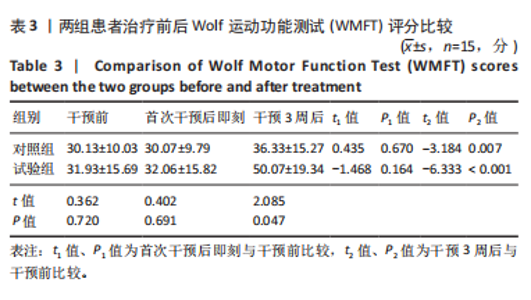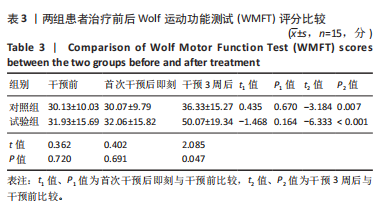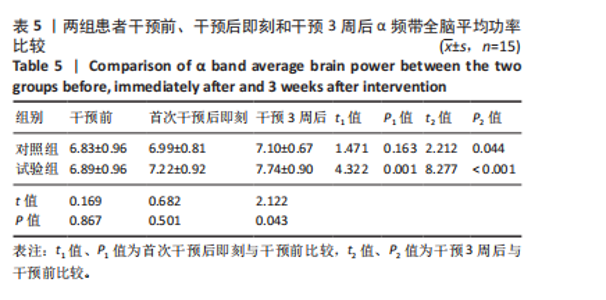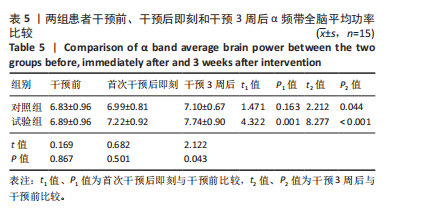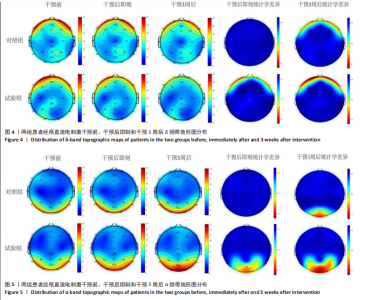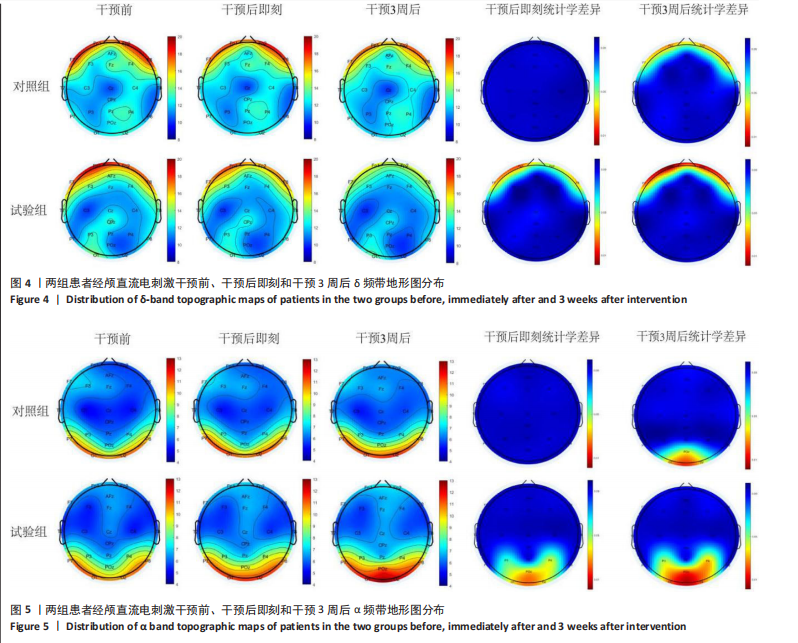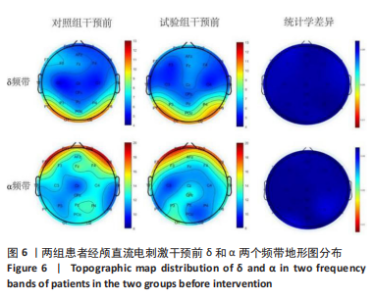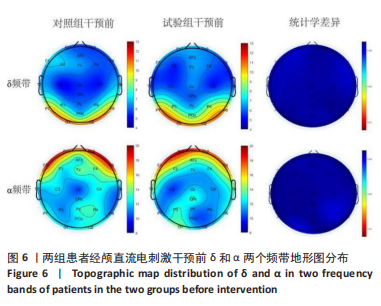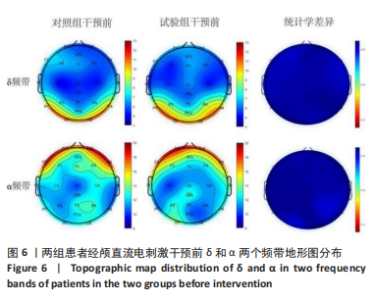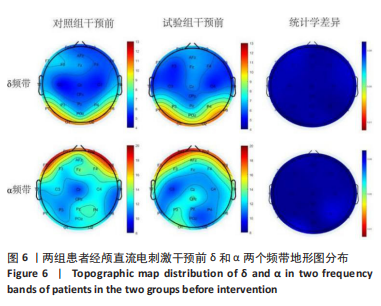Chinese Journal of Tissue Engineering Research ›› 2026, Vol. 30 ›› Issue (12): 3066-3074.doi: 10.12307/2026.667
Previous Articles Next Articles
Analysis of upper limb motor function and brain function immediately and 3 weeks after transcranial direct current stimulation
Hou Bing1, Zhao Hongfei2, Che Pengcheng1, Wang Ziyi1, Gao Zan1, Chen Linyu1, Wang Jinzhi1, Dou Na1
- Hou Bing1, Zhao Hongfei2, Che Pengcheng1, Wang Ziyi1, Gao Zan1, Chen Linyu1, Wang Jinzhi1, Dou Na1
1School of Nursing and Rehabilitation, North China University of Science and Technology, Tangshan 063210, Hubei Province, China; 2Department of Rehabilitation Medicine, Zibo Central Hospital, Zibo 255000, Shandong Province, China
-
Received:2025-03-14Accepted:2025-08-09Online:2026-04-28Published:2025-09-29 -
Contact:Dou Na, MS, Associate professor, School of Nursing and Rehabilitation, North China University of Science and Technology, Tangshan 063210, Hubei Province, China -
About author:Hou Bing, MS candidate, Primary rehabilitation therapist, School of Nursing and Rehabilitation, North China University of Science and Technology, Tangshan 063210, Hubei Province, China -
Supported by:2024 Hebei Province Medical Science Research Project, No. 20240161 (to DN); Hebei Province Key Laboratory of Rehabilitation Engineering and Regenerative Medicine, No. SZX202327 (to CPC); Hebei Province “Robotics +” Application Leading Project (to CPC)
CLC Number:
Cite this article
Hou Bing, Zhao Hongfei, Che Pengcheng, Wang Ziyi, Gao Zan, Chen Linyu, Wang Jinzhi, Dou Na. Analysis of upper limb motor function and brain function immediately and 3 weeks after transcranial direct current stimulation[J]. Chinese Journal of Tissue Engineering Research, 2026, 30(12): 3066-3074.
share this article
Add to citation manager EndNote|Reference Manager|ProCite|BibTeX|RefWorks
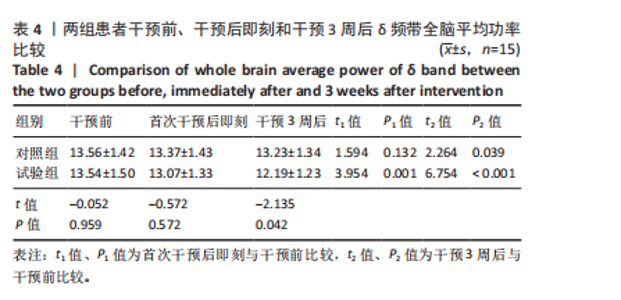
2.6 功率谱密度分析结果 2.6.1 δ频带能量地形图 施加真、伪tDCS前,δ频带能量主要集中在额叶和颞叶区。首次施加伪tDCS后,δ频带能量较干预前无明显变化(P > 0.05);经3周伪tDCS干预后,δ频带能量较干预前在额叶和颞叶区降低(P < 0.05)。首次施加双极tDCS后,δ频带能量较干预前在额叶和颞叶区降低(P < 0.05);经3周tDCS干预后,δ频带能量较干预前在额叶和颞叶区降低(P < 0.05),见图4。 2.6.2 α频带能量地形图 施加真、伪tDCS前,α频带能量主要集中在顶叶和枕叶区。首次施加伪tDCS后,α频带能量较干预前无明显变化(P > 0.05);经3周伪tDCS干预后,α频带能量较干预前在枕叶区升高(P < 0.05)。首次施加双极tDCS后,α频带能量较干预前在顶叶和枕叶区升高(P < 0.05);经3周tDCS干预后,α频带能量较干预前在顶叶和枕叶区升高(P < 0.05),见图5。真伪tDCS刺激前δ、α频带能量无显著性差异(P > 0.05),见图6。 2.7 δ、α全脑平均功率比较 2.7.1 干预前后两组患者δ频带全脑平均功率比较 与干预前比较,试验组干预后即刻δ频带全脑平均功率降低(P < 0.05),两组δ频带全脑平均功率组间无显著性差异(P > 0.05);干预3周后,两组δ频带全脑平均功率较干预前均降低(P < 0.05),试验组显著低于对照组(P < 0.05),见表4。"
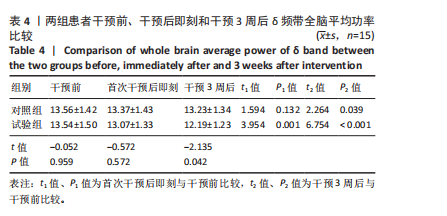
| [1] FESKE SK. Ischemic Stroke. Am J Med. 2021;134(12):1457-1464. [2] 陈渔,郭峰,郭建瑞,等.镜像视觉反馈训练中大脑运动皮质激活的脑电特征研究[J].中国康复理论与实践,2023,29(8):967-976. [3] GBD 2019 Stroke Collaborators. Global, regional, and national burden of stroke and its risk factors, 1990-2019: a systematic analysis for the Global Burden of Disease Study 2019. Lancet Neurol. 2021;20(10):795-820. [4] TATER P, PANDEY S. Post-stroke Movement Disorders: Clinical Spectrum, Pathogenesis, and Management. Neurol India. 2021;69(2):272-283. [5] 彭通,赵雅宁,刘瑶,等.三种类型经颅直流电刺激对脑卒中上肢偏瘫患者干预效果的网状Meta分析[J].中国循证医学杂志,2022, 22(12):1436-1444. [6] 庞争争,吕亚希,高春华,等.经颅直流电刺激对脑卒中患者上肢运动功能的效果[J].中国康复理论与实践,2023,29(3):275-279. [7] 张洁,王春方,杨飞,等.阴极经颅直流电刺激联合机器人治疗对脑卒中后上肢功能障碍的影响[J].中华物理医学与康复杂志,2021, 43(3):235-238. [8] KIM SH. Effects of Dual Transcranial Direct Current Stimulation and Modified Constraint-Induced Movement Therapy to Improve Upper-Limb Function after Stroke: A Double-Blinded, Pilot Randomized Controlled Trial. J Stroke Cerebrovasc Dis. 2021;30(9):105928. [9] LLORENS R, FUENTES MA, BORREGO A, et al. Effectiveness of a combined transcranial direct current stimulation and virtual reality-based intervention on upper limb function in chronic individuals post-stroke with persistent severe hemiparesis: a randomized controlled trial. J Neuroeng Rehabil. 2021;18(1):108. [10] KESER Z, BUCHL SC, SEVEN NA, et al. Electroencephalogram (EEG) With or Without Transcranial Magnetic Stimulation (TMS) as Biomarkers for Post-stroke Recovery: A Narrative Review. Front Neurol. 2022;13:827866. [11] HU Y, WANG Y, ZHANG R, et al. Assessing stroke rehabilitation degree based on quantitative EEG index and nonlinear parameters. Cogn Neurodyn. 2023;17(3):661-669. [12] WANG Z, LI J, WANG X, et al. Effect of transcranial direct-current stimulation on executive function and resting EEG after stroke: A pilot randomized controlled study. J Clin Neurosci. 2022;103:141-147. [13] WANG C, CHEN Y, SONG P, et al. Varied Response of EEG Rhythm to Different tDCS Protocols and Lesion Hemispheres in Stroke Subjects with Upper Limb Dysfunction. Neural Plast. 2022;2022:7790730. [14] AZARPAIKAN A, TAHERII TORBATI H, SOHRABI M, et al. Power spectral parameter variations after transcranial direct current stimulation in a bimanual coordination task. Adaptive Behavior. 2019;29:25-38. [15] LIU M, XU G, YU H, et al. Effects of Transcranial Direct Current Stimulation on EEG Power and Brain Functional Network in Stroke Patients. IEEE Trans Neural Syst Rehabil Eng. 2023;31:335-345. [16] 刘蒙蒙,徐桂芝,于洪丽,等.经颅直流电刺激下脑卒中患者脑电功率谱密度研究[J].生物医学工程学杂志,2022,39(3):498-506. [17] 中华医学会神经病学分会,中华医学会神经病学分会脑血管病学组.中国急性缺血性脑卒中诊治指南2018[J].中华神经科杂志, 2018,51(9):666-682. [18] HSU SP, LU CF, LIN BF, et al. Effects of bihemispheric transcranial direct current stimulation on motor recovery in subacute stroke patients: a double-blind, randomized sham-controlled trial. J Neuroeng Rehabil. 2023;20(1):27. [19] SANFORD J, MORELAND J, SWANSON LR, et al. Reliability of the Fugl-Meyer assessment for testing motor performance in patients following stroke. Phys Ther. 1993;73(7):447-454. [20] WU CY, FU T, LIN KC, et al. Assessing the streamlined Wolf motor function test as an outcome measure for stroke rehabilitation. Neurorehabil Neural Repair. 2011;25(2):194-199. [21] TAM PK, OEY NE, TANG N, et al. Facilitating Corticomotor Excitability of the Contralesional Hemisphere Using Non-Invasive Brain Stimulation to Improve Upper Limb Motor Recovery from Stroke-A Scoping Review. J Clin Med. 2024;13(15):4420. [22] SAES M, ZANDVLIET SB, ANDRINGA AS, et al. Is Resting-State EEG Longitudinally Associated With Recovery of Clinical Neurological Impairments Early Poststroke? A Prospective Cohort Study. Neurorehabil Neural Repair. 2020;34(5):389-402. [23] BOLOGNINI N, RUSSO C, SOUZA CARNEIRO MI, et al. Bi-hemispheric transcranial direct current stimulation for upper-limb hemiparesis in acute stroke: a randomized, double-blind, sham-controlled trial. Eur J Neurol. 2020;27(12):2473-2482. [24] 李冲.经颅直流电刺激联合手脑感知训练对亚急性期脑卒中上肢感觉运动功能的疗效研究[D].上海:上海体育学院,2023. [25] TEDESCO TRICCAS L, MEYER S, MANTINI D, et al. A systematic review investigating the relationship of electroencephalography and magnetoencephalography measurements with sensorimotor upper limb impairments after stroke. J Neurosci Methods. 2019;311:318-330. [26] LUK KY, OUYANG HX, PANG MYC. Low-Frequency rTMS over Contralesional M1 Increases Ipsilesional Cortical Excitability and Motor Function with Decreased Interhemispheric Asymmetry in Subacute Stroke: A Randomized Controlled Study. Neural Plast. 2022; 2022:3815357. [27] 贾杰.脑卒中后左右制衡机制及其对上肢手功能康复的意义[J].中国康复理论与实践,2018,24(12):1365-1370. [28] MIRDAMADI JL, XU J, AREVALO-ALAS KM, et al. State-dependent interhemispheric inhibition reveals individual differences in motor behavior in chronic stroke. Clin Neurophysiol. 2023;149:157-167. [29] WOODS AJ, ANTAL A, BIKSON M, et al. A technical guide to tDCS, and related non-invasive brain stimulation tools. Clin Neurophysiol. 2016;127(2):1031-1048. [30] BERNARDES TS, SANTOS KCS, NASCIMENTO MR, et al. Effects of anodal transcranial direct current stimulation over motor cortex on resting-state brain activity in the early subacute stroke phase: A power spectral density analysis. Clin Neurol Neurosurg. 2024;237:108134. [31] GARRIDO MM, ÁLVAREZ EE, ACEVEDO PF, et al. Early transcranial direct current stimulation with modified constraint-induced movement therapy for motor and functional upper limb recovery in hospitalized patients with stroke: A randomized, multicentre, double-blind, clinical trial. Brain Stimul. 2023;16(1):40-47. [32] FERREIRA LO, MATTOS BG, JÓIA DE MELLO V, et al. Increased Relative Delta Bandpower and Delta Indices Revealed by Continuous qEEG Monitoring in a Rat Model of Ischemia-Reperfusion. Front Neurol. 2021;12:645138. [33] JOHN ER, PRICHEP LS. The relevance of QEEG to the evaluation of behavioral disorders and pharmacological interventions. Clin EEG Neurosci. 2006;37(2):135-143. [34] LEON-CARRION J, MARTIN-RODRIGUEZ JF, DAMAS-LOPEZ J, et al. Delta-alpha ratio correlates with level of recovery after neurorehabilitation in patients with acquired brain injury. Clin Neurophysiol. 2009;120(6): 1039-1045. [35] SCHOMER DL, LOPES DA SILVA FH. Niedermeyer’s Electroencephalography: Basic Principles, Clinical Applications, and Related Fields. 6th ed. Philadelphia: Lippincott Williams & Wilkins, 2010. [36] 蒋瑞婷,倪琦超,王瑜佳,等.脑电图特征和神经肽Y与急性脑卒中后癫痫风险的相关性[J].中华全科医学,2024,22(7):1154-1157+1221. [37] MANSHANDEN I, DE MUNCK JC, SIMON NR, et al. Source localization of MEG sleep spindles and the relation to sources of alpha band rhythms. Clin Neurophysiol. 2002;113(12):1937-1947. [38] FANCIULLACCI C, BERTOLUCCI F, LAMOLA G, et al. Delta Power Is Higher and More Symmetrical in Ischemic Stroke Patients with Cortical Involvement. Front Hum Neurosci. 2017;11:385. [39] MIN YS, PARK JW, JANG KE, et al. Power Spectral Density Analysis of Long-Term Motor Recovery in Patients With Subacute Stroke. Neurorehabil Neural Repair. 2019;33(1):38-46. [40] 王耀辉,吕喆,张重阳,等.基于脑电信号样本熵的急性脑梗死患者溶栓效果评价[J].中国医学物理学杂志,2022,39(1):81-86. [41] 程振仕.基于EEG的脑卒中评估方法研究及病灶定位[D].秦皇岛:燕山大学,2019. |
| [1] | Wang Zheng, Cheng Ji, Yu Jinlong, Liu Wenhong, Wang Zhaohong, Zhou Luxing. Progress and future perspectives on the application of hydrogel materials in stroke therapy [J]. Chinese Journal of Tissue Engineering Research, 2026, 30(8): 2081-2090. |
| [2] | Gao Feng, Zhang Jun, Yu Wenjun, Chanyu Yujing, Zhao Le, Hu Yuting, Wang Junhua, Liu Yongfu. Effects of wrist-hand orthosis on hand dysfunction in stroke patients: a meta-analysis [J]. Chinese Journal of Tissue Engineering Research, 2026, 30(8): 2124-2131. |
| [3] | Tao Daiju, Su Haiyu, Wang Yuqi, Shen Zhiqiang, He Bo . Construction and identification of stable PC12 cell lines with high/low expression of miR-122-5p [J]. Chinese Journal of Tissue Engineering Research, 2026, 30(7): 1790-1799. |
| [4] | Zhou Jian, Zhang Tao, Zhou Weili, Zhao Xingcheng, Wang Jun, Shen Jie, Qian Li, Lu Ming. Effects of resistance training on quadriceps mass and knee joint function in patients with osteoporosis and sarcopenia [J]. Chinese Journal of Tissue Engineering Research, 2026, 30(5): 1081-1088. |
| [5] | Yang Yuanyuan, Zhou Shanshan, Cheng Xiaofei, Feng Luye, Tang Jiqin. Network meta-analysis of non-invasive brain stimulation in the treatment of lower limb motor dysfunction after stroke [J]. Chinese Journal of Tissue Engineering Research, 2026, 30(4): 1008-1018. |
| [6] | Ma Shanxin, Zheng Jianling, Cheng Jian, Lin Xi, Li Qiuyuan, Wang Li, Zeng Yangkang, Song Luping. Early intelligent active assistance in walking for hemiplegic patients under suspension protection: #br# a randomized controlled trial [J]. Chinese Journal of Tissue Engineering Research, 2026, 30(12): 3075-3082. |
| [7] | Gao Shiai, Chen Jinhui, Cao Xinyan, Leng Xiaoxuan, Liu Xihua. Abdominal electrical stimulation combined with core stabilization training improves balance and cough function in patients with stroke pseudobulbar palsy [J]. Chinese Journal of Tissue Engineering Research, 2026, 30(11): 2736-2744. |
| [8] |
Zhang Yueting, Li Jinglin, Fu Zhenyi, Yan Fei, Gao Yu, Liu Jiaxin.
Endoplasmic reticulum stress promotes ferroptosis and aggravates cerebral ischemia-reperfusion injury#br#
#br#
[J]. Chinese Journal of Tissue Engineering Research, 2026, 30(11): 2806-2813.
|
| [9] | Wang Degang, , Chen Guohua, , Mei Junhua, Wang Junli, Zheng Li. Effects of nocturnal sleep duration on new-onset cardiovascular and cerebrovascular diseases in middle-aged and elderly patients with chronic comorbidities [J]. Chinese Journal of Tissue Engineering Research, 2026, 30(11): 2814-2822. |
| [10] | Zhou Xinying, Sun Xinyue, Zhu Wenhao. Insulin-like growth factors and ischemic stroke: a genome-wide association analysis in European populations [J]. Chinese Journal of Tissue Engineering Research, 2026, 30(11): 2909-2919. |
| [11] | Hu Xin, Wan Haili, Du Liang, Li Yongjie, Xia Yuan. Theta-stimulation for the treatment of motor function and daily activity ability in the lower extremities of stroke patients: a meta-analysis [J]. Chinese Journal of Tissue Engineering Research, 2026, 30(10): 2576-2583. |
| [12] | Tian Meng, Lou Tianwei, Zhang Yongchen, Jia Hongling . Cathepsin F as a potential serum biomarker for stroke risk prediction: GWAS database data analysis [J]. Chinese Journal of Tissue Engineering Research, 2026, 30(10): 2662-2670. |
| [13] | Wang Zheng, Cheng Ji, Yu Jinlong, Liu Wenhong, Wang Zhaohong, Zhou Luxing. Progress and future perspectives on the application of hydrogel materials in stroke therapy [J]. Chinese Journal of Tissue Engineering Research, 2025, 29(在线): 1-10. |
| [14] | Wang Mi, Ma Shujie, Liu Yang, Qi Rui. Identification and validation of characterized gene NFE2L2 for ferroptosis in ischemic stroke [J]. Chinese Journal of Tissue Engineering Research, 2025, 29(7): 1466-1474. |
| [15] | Gao Yang, Qin Hewei, Liu Dandan. ACSL4 mediates ferroptosis and its potential role in atherosclerotic cardiovascular disease [J]. Chinese Journal of Tissue Engineering Research, 2025, 29(6): 1239-1247. |
| Viewed | ||||||
|
Full text |
|
|||||
|
Abstract |
|
|||||
